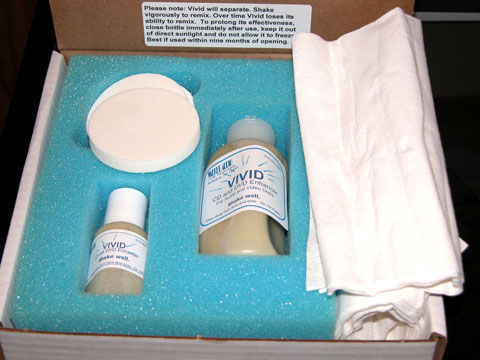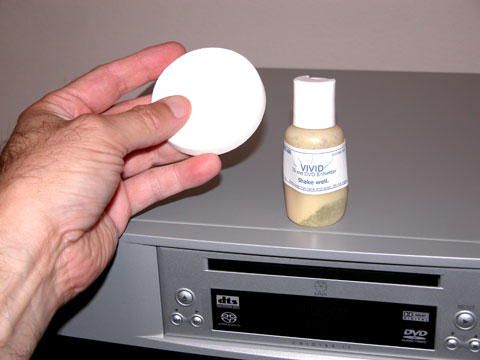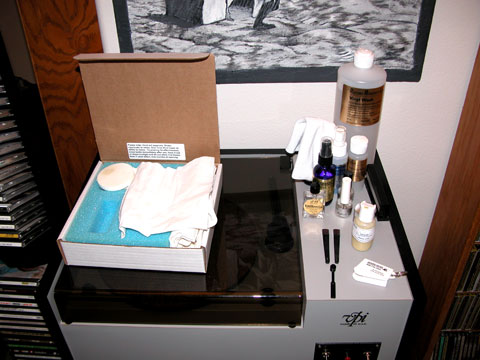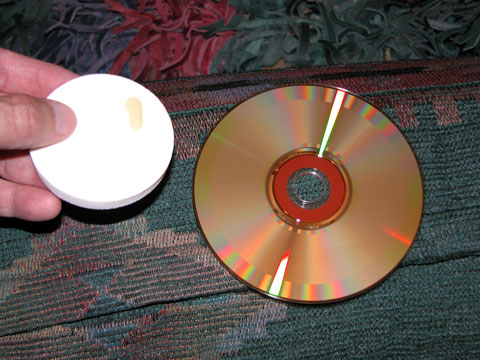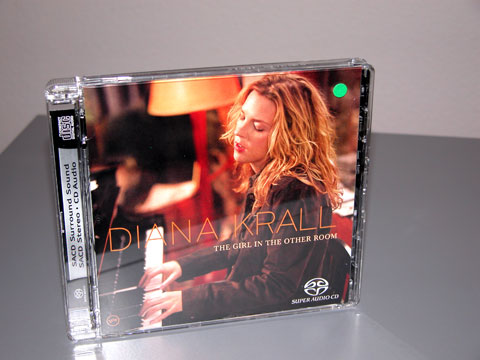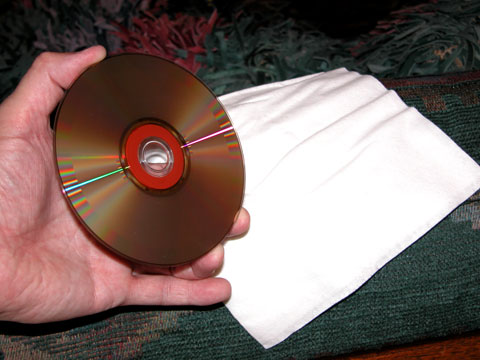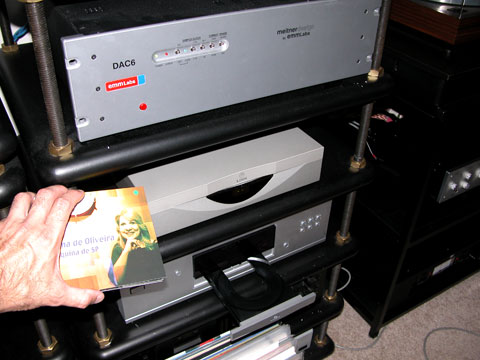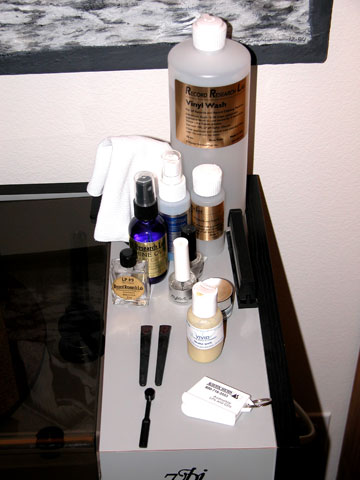|
You are reading the older HTML site
Positive Feedback ISSUE
14
Impressions: The Walker Audio Vivid SACD/DVD Enhancer
All photographs and image processing by Robinson "Demme me eyes! How does he do it?!" - Ye Olde Scurvy Editor About those digital enhancing treatments...
The Vivid Deluxe kit: treatment solution, pads and wipes Surface treatments and enhancement treatments/tweaks for digital discs are nothing new. For years now, a number of sprays, goos, compounds, polishes, and compounds have been touted by a number of audio manufacturers, all claiming to have found the formula for audio nirvana. These have ranged from simple "scratch busters" or Sam Tellig's espousal of Armor All™ (remember that controversy?) as a palliative for what ailed CDs, all the way up to sophisticated, low-volume specialty treatments like JENA Labs' Esoteric Mist™ or Record Research Labs Shine-Ola™. All along the way, a long-standing argument about the efficacy of these products has been fought, on a battleground drawn roughly between the "bits is bits"/"surface treatments are snake oil" crowd on the one hand, and the "use yer ears"/"don't care what the double-blind think" gang. (I don't think that war will ever be finished—which is no surprise, since it's a conflict of worldviews, and not merely of opinions or preferences.) C'est la guerre de audio. Meanwhile, that argument is neither here nor there at this end of things. Argument for its own sake is bloody boring, and isn't worth the time and effort. (Those who disagree are hereby politely referred to /dev/null, or a local tree stump, whichever is easier.) Long-time readers know that I have tried a number of digital treatments and enhancements over many years now. There is no doubt in my mind that the good stuff really works. I have found a handful that wrought undeniable improvements in digital playback to these ears in my listening room: the Bedini Clarifier and UltraClarifier, Clark Johnsen's recommendation to use powerful degaussers on CDs (Clark was the first to advocate this, to my knowledge), the application of strong fluorescent light treatments to SACDs (that one via Clay Swartz), Record Research Labs Shine-Ola (more on that some time) on SACDs, and a particular favorite of mine — JENA Labs' exceptional Esoteric Mist for both SACDs and CDs. The JENA Labs product, like so many of the designs that Jennifer has developed, is truly excellent. Three or four squirts of this bluish solution, a polishing with a disc pad, and both SACDs and CDs really did sound better than before. The problem with Esoteric Mist is that its supply is very short, since it is currently out of production. I have a bottle left, and then... well... . You know, it's heartbreaking when a favored product is no longer being made. But there is good news. I've finally found a replacement for my much-lamented, departing Esoteric Mist: Walker Audio's ViViD SACD/DVD/CD Enhancer. For the details, read on, Pilgrim...
A 1 oz. bottle of Vivid, with one of its foam polishing pads The remarkable Maestro Walker I've been talking with Lloyd Walker via phone every few weeks over the past five or six months, because I find him to have a wealth of information on fine audio, and getting the most out of your system. Over the years I've been blessed with a number of good friends in fine audio whose sensibilities I have come to respect, and have learned a lot from them about where the gold is... and where it ain't. If you start out with the assumption that you don't know it all—work hard to listen, to evaluate carefully—then you may be able to morph sense into sensibility. My conversations with Lloyd Walker over the past six months, coupled with listening to products like his SST Contact Enhancer (see my review of SST) confirms that he's one of those rare folks who really knows what audio gold is, and where to find it. We've spent hours discussing how to get the most out of turntables, cables, power supplies, as well as the importance of system synergy. While he and I were talking a few months ago about tweaking/enhancing products like his SST, he also mentioned that he had a product called ViViD™ for treating SACDs, DVDs, and CDs. Would I like to give it a try? My main interest in any new product was in applying it to SACDs. However, anyone who's followed SACDs over the past year or two knows that there were serious questions for a time about applying any surface treatment to the hybrids coming out of Sonopress in Germany. I therefore asked Lloyd if he was sure that using Vivid wouldn't cause problems with the SACDs it was applied to... I have no interest in replacing any of my discs. Lloyd was familiar with the problem, and said that apart from that batch of SACDs, it was safe to use Vivid on hybrid SACDs. Given the declining level of Esoteric Mist in my JENA Labs bottle, this question wasn't hard to answer. Sure ‘nuff! Send it along! How to use it
The Vivid Deluxe Kit joins its brethren in the cleaning/tweaking/enhancing section of the listening room; the 1 oz. dispensing bottle is to the right front, by the stylus brushes. A Vivid polishing cloth lays on top of the box. The Vivid kit arrived shortly after Lloyd and I talked about it. I had used a number of surface enhancement products for discs, and am comfortable in applying them. Vivid was different, though. Most of the solutions I've used were applied with sprayers, and polished with a wipe cloth; Vivid is dispensed from a plastic bottle equipped with a fold-out drip spout. Three drops of Vivid are placed on a special foam pad, which are then rapidly applied to the SACD from the center hub outwards in a radial motion. (You should never use circular application with any digital disc, as this can cause the error rate to increase.) You then take the wipe cloth and polish the disc rapidly from side-to-side across the diameter of the SACD until the disc is shiny and clear of any haze.
Three drops of Vivid on the foam pad about to be applied to an SACD Having spent some time reading the instructions, I followed Walker Audio's procedure carefully. I shook the 1 oz. bottle rapidly for a few seconds, then immediately placed three drops on the foam pad. Holding the disk around its circumference with the fingers of my left hand, I used the right hand to apply the treatment radially. Once the disc was covered, I set aside the pad and began polishing the disc with the disc wipe, making sure that I always did so across a diameter of the disc. Every half-dozen or so passes, I would pause for a second, rotate the disc slightly in my left hand to change the angle, and polish again. I continue to do this until the SACD is uniformly brilliant, and free of residual haze. The foam pad can be used until all clear areas have been utilized; then you can wash it out with water and dry it for another set. It may take a bit of practice, but once you get the hang of it, it's really pretty simple. When I finished with a disc, I returned it to its jewel box. To remind me of which SACDs have been treated, I put a stick-on green dot on the outside of the cover when I'm done. (I'd suggest that you do some variation of the same thing... it will save you time, frustration and money.) This is the only way to avoid insanity, particularly if you're doing larger sets of discs in one session.
Diana Krall's latest SACD: treated, "green-dotted" and ready to take out for a spin... The Sound As always, the main question is "OK, so what does it do, and how does it make your discs sound?" Let's start out by noting that, in my experience, my reference EMM Labs system is the top of the heap for both SACD and CD playback. No surprise there; I've said that on many occasions. The level of audio reproduction is really spectacular, and there are no obvious weaknesses in Meitner's system (though I am awaiting the arrival of the new EMM Labs CDSD transport with real anticipation). As usual, though, enjoying "the top of the heap" doesn't necessarily mean that there isn't a bigger "heap" waiting to take you to the next level. And how many times have you been jumped by an improvement in an audio system that you were sure was already "the best it could be"? (Come on... be honest!) Well, that's what happened to me (again) when I began to use Vivid on SACDs.
An SACD immediately after polishing... ready to roll! It was really strange: with the Vivid-treated SACDs that I tried, I found that when I listened with my eyes closed, it was almost as if the far end of the listening room was expanding outside the walls and into space. I don't have an explanation for this effect, unless stereo soundstaging and imaging were improving somewhat, and allowing for a better "feel" with those discs. I also noticed that there seemed to be an even better transparency, an improved tonal purity with any SACD that I tried the Vivid on. The EMM Labs DAC6 is already the champion when it comes to rendering the tactile, and giving a superlative sense of timbre and tonality, even with rock and roll (e.g., the Creedence Clearwater SACDs from Chad Kassem's Analogue Productions); to find that there was "mo' bettah" even in this area was pretty startling. Percussives were both more detailed and smoother—another effect that caused me to ponder more than just a bit. (Remember that all of this is via the Meitnerized Philips SACD 1000 transport... I am wondering how all of this will play out on the new EMM Labs CDSD transport.) In a very real sense, I found that Vivid helped the clarity of any SACD that I applied it to, regardless of genre. Another thing: roundness of imaging was better, too. By "roundness" I mean the sense that there is a "back" to the "front" of what you're hearing in a stereo recording, that there is a greater three-dimensionality to the playback sound. It was not a huge step forward, but it was definite. Even with the EMM Labs gear, more could be had using Vivid. Because of the greater clarity, I also adjudged the dynamics of SACDs to be better with Vivid than without. As always, anything that clears our "listening window" to a recording makes the movement from silence to fortissimo all the more obvious.
Making sure of the Vivid magic: treated and untreated SACDs (Wilma de Oliveira's wonderful Esquina de SP, Brasilian Samba in pure DSD!) for rapid comparisons. There is a problem with such "before and after" comparisons, however. Aural memory is a very slippery thing, with relatively small persistence. Even experienced listeners can have a hard time qualifying their impressions if too much time goes by. Listening to an SACD, then popping it out, treating it with Vivid, then popping it back in for a comparison takes several minutes. Worse, there's no way to go back to double-check your impressions. Unless, of course, you use two SACDs. Which is what I did with a couple of my SA's. Just to be quite sure of what I have described to you, I brought in second copies of Diana Krall's The Girl in the Other Room and Wilma de Oliveira's Esquina de SP. One SACD was treated with Vivid, the other was left untreated. This allowed me to go back and forth between the treated and the untreated discs, so that I could be sure of what I was hearing and have described to you. Doing so underlined my earlier impressions. After going back and forth between the two, there was no doubt in my mind that the Vivid-treated SACDs were more transparent, rounder, more detailed, and more dynamic. If anything, the pure DSD, minimalistic Esquina benefited more from Vivid than did the more highly processed Krall recording. Huh! Impressive! Furthermore, I have seen no evidence of any re-hazing, or of any chemical nastiness so far with the SACDs that I have treated... though you have to remember that I've only been using Vivid for a few months now. Lloyd Walker says that if you use it properly, and stay away from the problematic early pressings of Sonopress hybrids, you should be OK. Coming soon: my impressions of Vivid on the video performance of DVDs, via component input to our 65" Toshiba High-Definition set.
De Oliveira's pure DSD SACD, treated with Vivid, being loaded into the EMM Labs reference system for a comparison. Sine qua non Well, what can I say? Once more I'm humbled to learn that behind every mountain peak I've climbed in my audio journey is another, higher one, beckoning me on. Every time I say to myself, "Outstanding! We're there!" something comes along to tell me, "No, that isn't all there is—turn the page!" And I guess we ought to be thankful that fine audio is that way, and that faithful passion is rewarded with new vistas, and new possibilities. Vivid makes it clear that there's "more there, there" on our SACDs. I now consider it to be an indispensable addition to my library of enhancements and treatments, and a reasonable way to discover how much more magic and how much more joy your system is capable of producing for you. Like Walker Audio's SST Contact Enhancer, Vivid has become that rare sine qua non treatment in my listening room... and I think it will be in yours, as well. You really owe it to yourself to give Vivid a try; with a 30 day money-back guarantee and no evidence of problems with any SACDs that I applied Vivid to, I'd say that you have nothing to lose.
Vivid joins the ranks! I therefore give the Walker Audio Vivid SACD/DVD/CD Enhancer a "Ye Olde Editor's Very Highest Recommendation!" Configurations/Prices: Vivid Deluxe Kit: $70; includes one 4.5 ounce bottle, one 1 ounce bottle, 6 wipers, 3 applications pads, and instructions. Vivid Basic Kit: $45; includes one 3.5 ounce bottle, 3 wipers, 1 application pad, and instructions.
Walker Audio
|

